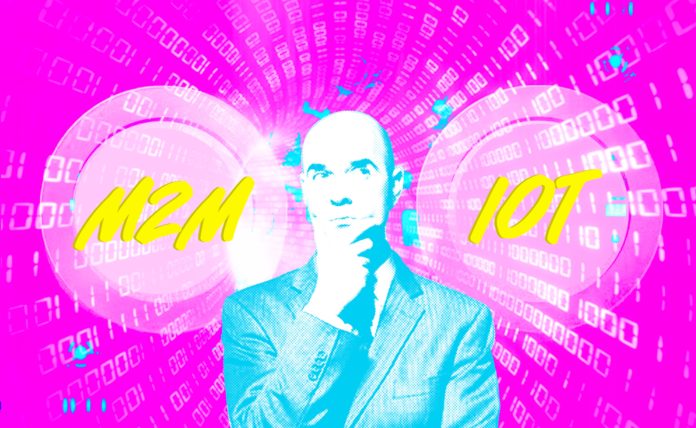Two of the technologies that you’ll often hear about when discussing device networking are M2M (machine-to-machine) and IoT (Internet of Things).
In this article, the author (source www.iotforall.com) define M2M and IoT, as well as examine the major ways in which the two are different. Once we understand the differences between the two, we’ll be able to identify which one can better serve our business applications.
What Is M2M?
M2M, or machine-to-machine, is the foundation of the sophisticated device connectivity that we enjoy today. An M2M connection is a point-to-point connection between two network devices that allows them to transmit information via public networking technologies such as Ethernet and cellular networks.
Sensor telemetry is one of the original uses of M2M communication. For decades, businesses have used M2M to remotely monitor factors like temperature, energy consumption, moisture, pressure and more through sensors.
ATMs offer another great example of M2M technology. The ATM’s internal computer is constantly communicating with a host processor that routes transactions to the appropriate banks and accounts. The banks then send back approval codes through the host processor, allowing transactions to be completed.
What makes this an example of M2M technology is that the entire transaction happens remotely and without any need for a human operator on the bank’s side. Machines communicate smoothly, efficiently and automatically, allowing transactions to be authorized in seconds. M2M technology has a decades-long track record of improving the world’s ability to communicate and execute transactions effectively across long distances and in real time.
What Is IoT?
IoT, or the Internet of Things, is an evolution of M2M that increases the things that device connectivity can achieve at both a consumer and an enterprise level. IoT takes the basic concepts of M2M and expands them outward by creating large “cloud” networks of devices that communicate with one another through cloud networking platforms. The technologies used by IoT devices allow users to create fast, flexible, high-performance networks that connect a wide variety of devices.
Examples of IoT devices are all around us today. Smart home voice assistants like Alexa and Google Home are some of the most high-profile examples, along with the huge array of smart home devices that they connect to. But you’ll also find IoT devices used in enterprise applications for purposes such as monitoring cargo temperatures, tracking shipments and evaluating employee performance. Any network of devices that’s connected to the Internet and uses a cloud platform to communicate can be considered part of the IoT.
So, why is it that IoT applications are practically synonymous with cloud computing? The reason is that cloud architecture provides much of the infrastructure, platforms and software that IoT devices use to operate scalable and reliable networks. While IoT can function outside of the cloud, it’s the cloud that makes it useful to businesses and consumers.
M2M vs. IoT: Main Differences
First, it’s important to know that IoT is itself a subset of M2M technology. IoT involves communication between machines without human input, making it by definition a form of M2M communication. However, IoT expands the power and potential of M2M technology in new ways.
The biggest difference between M2M and IoT is that an M2M system uses point-to-point communication. An IoT system, meanwhile, typically situates its devices within a global cloud network that allows larger-scale integration and more sophisticated applications.
Scalability is another key difference between M2M and IoT. IoT is designed to be highly scalable since devices can often be added to a network and integrated into existing systems with minimal hassle. M2M networks can also be more labor-intensive to set up and maintain, since new point-to-point connections must be created for each device. (Think of the effort it takes to install a new ATM as opposed to adding a new smart device to your home’s network.)
The term “IoT” also typically refers to wireless devices, while M2M may or may not involve wireless communication. The wireless nature of most IoT devices can be both a blessing and a curse, requiring less maintenance of technologies such as Ethernet networks but shifting the burden to WiFi networks, which can be less reliable and have problems of their own.
M2M vs. IoT: Making the Choice
Is M2M or IoT technology the preferable option for your application? The answer to the latter depends on what you need from your device communications technology. There’s no one-size-fits-all solution when it comes to device networking. Pick the option that makes the most sense for your business.
M2M technology may be a better choice if:
- Your application requires point-to-point communication between machines
- Your application has a limited set of specific machine communication needs that need to be executed quickly and reliably
- Your application needs to be operational whether or not a WiFi connection is available
- Rapid scalability is not a primary concern for your network
- Your device network needs to be isolated for security reasons
On the other hand, IoT may be the best option if:
- Your application requires real-time syncing of many different devices throughout a networking cloud
- Your devices have access to a fast and reliable WiFi connection
- Devices on your network need the ability to communicate with multiple other devices simultaneously
- Your application requires smooth and easy scalability for large numbers of devices and users
- Your application requires the ability to make its data and devices compatible with multiple standards
M2M and IoT are both key technologies for today’s business and consumer markets. As these technologies continue to develop, they’ll create new opportunities for those who understand them and can leverage each technology’s strengths effectively.
Source www.iotforall.com


